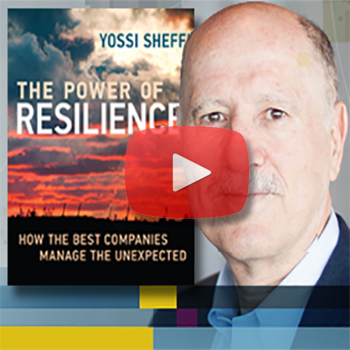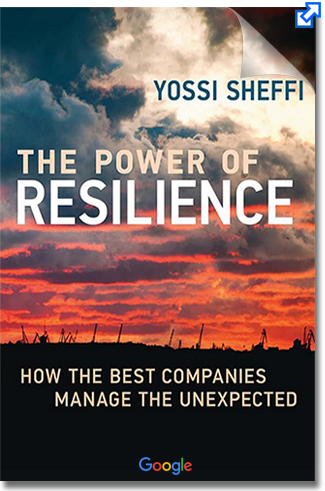Yossi Sheffi on ‘The Power of Resilience’

Yossi Sheffi talks about his new book, The Power Of Resilience: How The Best Companies Manage The Unexpected, and how the best companies are balancing the risks involved in new products, new markets, and new processes - all crucial for growth - and the resilience created by advanced risk management.
Yossi Sheffi has been writing about transportation, logistics, and supply chain management since as far back as 1985, when he published Urban Transportation Networks.
Since then, he has tackled a variety of topics important to supply chain managers, including logistics clusters and supply chain resiliency.
A professor at the Massachusetts Institute of Technology, where he serves as Director of the MIT Center for Transportation & Logistics (MIT CTL), he is an expert in systems optimization, risk analysis, and supply chain management.
In his latest book, The Power Of Resilience: How The Best Companies Manage The Unexpected, Sheffi returns to the subject of supply chain resiliency, or the ability to bounce back from the type of disruptions that are all too common in today’s global, interconnected supply chains.
You can read excerpts from The Power Of Resilience on Supply Chain Management Review, and on Google Books.
I recently had a chance to talk to Sheffi about why this topic and why now.
Let’s start with an easy one: What was the motivation for this book?
I started thinking about this more than 10 yeas ago. After 9/11, I was on sabbatical in the UK. I was meeting in the Home Office and they said the next Al Qaeda attack will be on the private sector.
The British Government provided the funding for The Resilient Enterprise, which was the first book I published on this subject in 2005.
Ten years later, I spoke to people who said that the book came out before Katrina, the volcanic eruption in Iceland, and the tsunamis in Thailand and Japan.
The risks have grown, and friends thought it was time to revisit the whole idea.
In this book, you’re really making the distinction between risk management and resiliency. It seems as if risk management is only first step; that, rather, how a company recovers from the unexpected, is as important, or more important, than identifying the risks in your supply chain.
In other words, its one thing to have home owners insurance in case your house burns down; its another thing entirely to file a claim, find a temporary place to live; hire a contractor to repair or rebuild your home; and replace your belongings in a timely fashion.
Well, you can’t do much if you don’t prepare and part of the preparation is identifying the risks in your supply chain.
And, there are really two types of risks. Some are events that have happened to you and other people before.
For instance, hurricanes in the Gulf happen every year and a company like Cisco has a playbook for these. The other is the types of events that haven’t happened before.
The Japanese tsunami wasn’t just a disruption, it was a nuclear meltdown. You don’t have a playbook for that. However, there are certain generic things you can do regardless of the type of disruption, the anticipated and unanticipated. For instance, if you set up fire fighting equipment, you have the option to use it.
It’s things like phone trees. If you plan for the disruption, you have a set of things to do for things you can imagine and for things you cannot.
I just finished reading the first chapter about Intel’s experience with the Japanese Tsunami. That comes up in other articles on this topic.
Were Katrina, the volcanic eruption in Iceland and Japan watershed events that forced companies to think beyond risk management and focus on resilience and continuity planning in new ways?
The Tsunami was a Black Swan: It was an unknown unknown. We could not imagine it. So were 9/11, the explosion in the Gulf, and the Icelandic eruption.
They were totally unanticipated. Let me ask you a question: What is the worst disruption you can talk about?
The answer to the question is that it didn’t happen yet. I think what happened is that people realized that future disruptions could be bigger than anything that’s happened before. The past is bounded; the future is unbounded. The fact that some of these big unanticipated events took place one after another sensitized people to the fact that stuff happens.
The unexpected can happen and it can be really bad. If you want a more current event, you don’t have to go too far back to look at what just happened to Volkswagen. It could have an impact on the entire German or European car industry. Yet, if someone had told you that a car company would massively cheat, your first guess would not have been Volkswagen.
A quality issue can also challenge a company. Look at what Boeing and Airbus have gone through as they try to incorporate these different materials in their aircraft. They’re not just new, there’s a lack of capacity in the marketplace and it’s not clear that manufacturers can ramp up that quickly.
In the garment industry, there’s the tremendous pressure on prices that is driving manufacturers into emerging markets, and all the issues in those places. And, with the Arab spring, we had political activities to contend with.
One of the things you write about in the first chapter is the complexity that comes with extended, global supply chains.
In 2012, there was an explosion at Evonik, a German chemical plant that made over 50% of the supply of a type of plastic resin used in the manufacturing of auto parts.
The whole industry came to its knees because everyone was using the same supplier, except that they were five tiers down the supply chain, so many companies didn’t even realize it was an issue until Dow Chemical raised a flag.
The Automotive Industry Action Group ended up coming together to get other companies to make the chemical. It illustrates the fact that supply chains are deep, and it’s hard to find out that everyone in the industry is relying on the same supplier.
It’s not just China or India to Miami. It could be China to China to China to India to India to Miami. Think about conflict minerals. You may have to go down to Tier 10 in your supply chain to find the smelter in Brazil. You tell them not to use stuff from the Congo, and they wonder who are you to tell them what to do?
In this instance, the whole electronics industry had to come together to go deep into the supply chain. When it comes to corporate social responsibility, if a Tier 3 supplier in China is found to be using sweat labor, no one attacks the Tier 3. Your dinged with it because that’s where organizations have leverage.
What’s the one message you want readers to take away from the book?
At the end of the day, this is a board responsibility. Executives and line officers have to work on the day to day. But, we have to make sure that we don’t have an existential threat.
The message should be to the board that they have to keep the management’s feet to the fire.
Related: Countries That Have the Most Resilient Supply Chains

Article Topics
MIT Center for Transportation and Logistics News & Resources
Supply Chain’s Next Decade of Dealing With the Unknown Sustainability Efforts Continue to Ramp Up, Research Finds Supply Chain Sourcing Alternatives to China DAT’s Caplice Reviews Spot Market Strategy for 2024 Budget Planning Yellow’s Demise Underscores the Need for a New Labor Relations Narrative Is Your Supply Chain Talent Ready for the Future? The Rebound Podcast: Yossi Sheffi and The Magic Conveyor Belt More MIT Center for Transportation and LogisticsLatest in Supply Chain
Microsoft Unveils New AI Innovations For Warehouses Let’s Spend Five Minutes Talking About ... Malaysia Baltimore Bridge Collapse: Impact on Freight Navigating TIm Cook Says Apple Plans to Increase Investments in Vietnam Amazon Logistics’ Growth Shakes Up Shipping Industry in 2023 Spotlight Startup: Cart.com is Reimagining Logistics Walmart and Swisslog Expand Partnership with New Texas Facility More Supply ChainAbout the Author
















